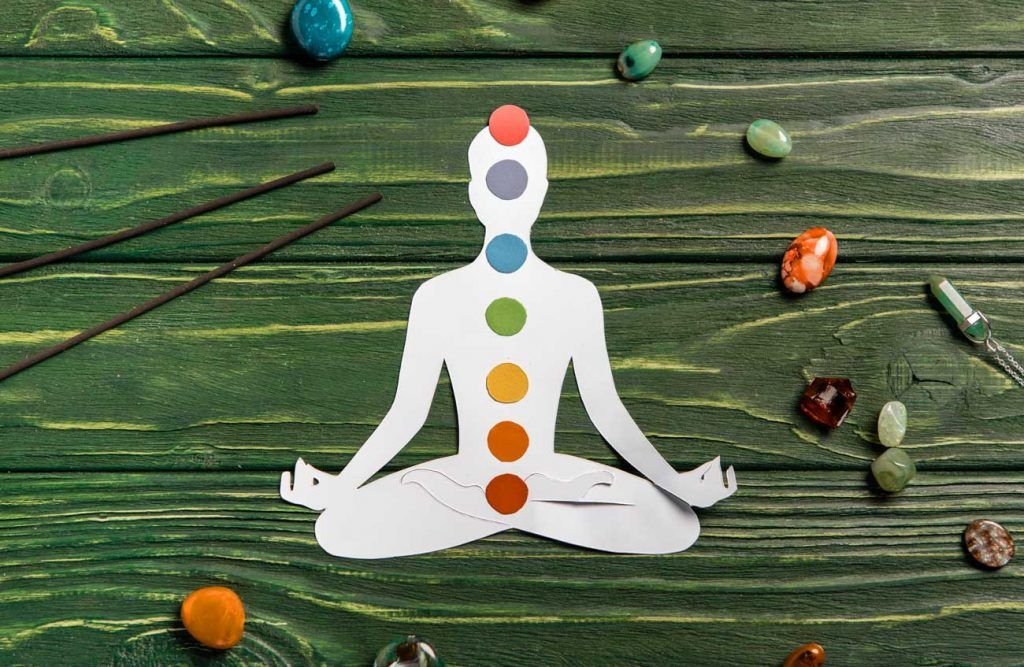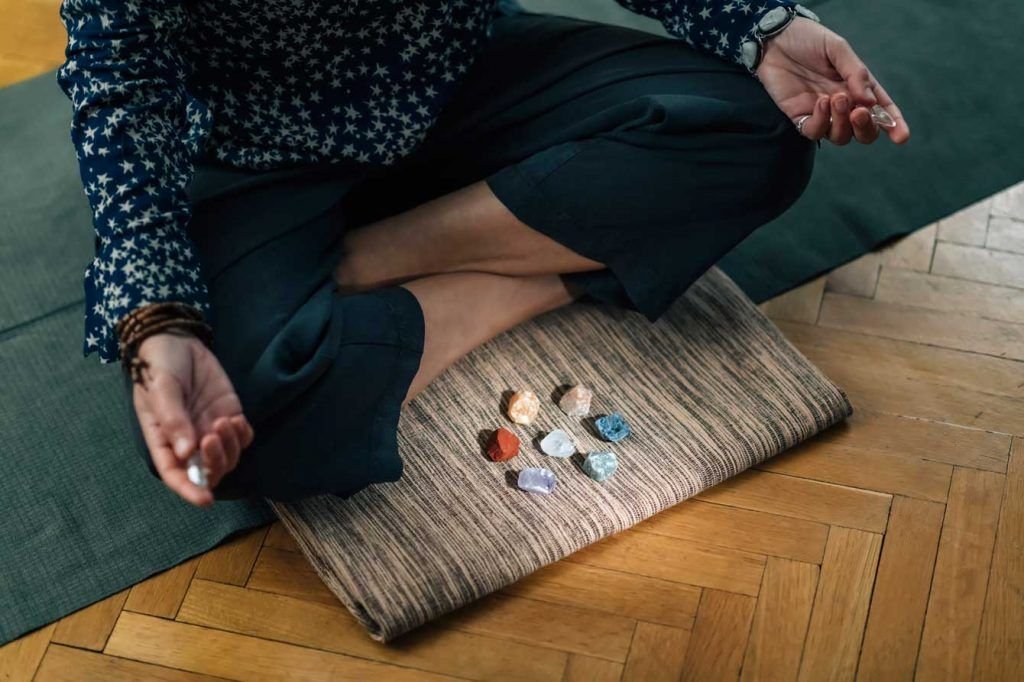
Energy currents flow through us, strengthen our body and are our source of energy. They are like rotating centers in our body: the chakras.
Have you ever wondered where we get our strength and inner energy from? Where does the phrase “be at peace with yourself” come from? If you have taken a few yoga classes or are interested in lithotherapy, you have probably come across the word chakra.
Chakras regulate the energy within us and can transform life energy into physical energy. Each chakra has its own frequency, is associated with a specific location in the body, and performs individual functions. I suggest you shed some light on this in this article.
What is the meaning of the chakras?
Chakra is a Sanskrit word meaning circle. The chakras radiate life energy, which is called prana in Ayurveda. The chakras are the subtle energy centers of our body. We can think of them as whirlwinds spinning in the body. They are also often represented by flowers (hence the famous flower of life that you can find in some of my jewelry: ). When the chakra is open and activated, it spins like an energy vortex and supplies the whole body with life energy.
However, if the chakras are blocked, life energy can no longer circulate throughout the body and disturbances occur. Wherever the energy flows cross in our body, they form small nodes. These points are the many minor chakras. In addition, there are seven main chakras, all running along the spine, from which our life energy emanates.
What are the seven main chakras?

The main chakras are all located along the spine. Each of the seven main chakras is characterized by different properties. Different properties and physical signs can be assigned to each energy center. Depending on which chakra is blocked, other mental or physical disorders will occur.
The root chakra
The root chakra regulates survival. It is the connection to everything earthly. It represents the earth, balance, life force, willpower, stability, courage and perseverance. Blockage: anxiety, depression, distrust, fits of anger, lack of self-confidence, lack of strength. Position: pelvic floor Red color Shape: Four-petaled lotus flower
The sacral chakra
It is also called the sexual chakra. The sacral chakra is located about a hand’s width below the navel. It is the center of our zest for life, sexuality, partnership, creativity, lust, sensuality and emotions.
Blockages: Feelings of guilt, worries, sexual disorders, situations of lack, lack of joy. We feel this, for example, through decreasing libido, tension in the back and muscles, negative emotions such as anger, sadness and jealousy. Position: Lower abdomen Orange color Shape: 6-petaled lotus
The Solar Plexus Chakra / The Navel Chakra
This chakra is the seat of our personality and personal responsibility. It represents self-esteem, balanced emotions, good instincts, decision-making ability, inner independence and empowerment. It is located approximately at the level of the stomach, directly above the solar plexus. Blockage: emotional fluctuations, power issues, need for control, grief, decision-making problems, addictions. These manifest in restlessness and materialism. The physical consequences are: Obesity, abdominal pain or lack of strength. Position: Upper abdomen Yellow color Shape: 10-petaled lotus flower
The Heart Chakra
The heart chakra sits directly above our heart and is the center of love. Compassion, harmony, warmth of heart, reconciliation, peace, kindness and healing go hand in hand with it. Blockage: lack of love, coldness, lack of contact, reproach, prejudice, resentment, bitterness, strife, sadness. Physically, a disturbance of the heart chakra manifests in the heart, lungs, skin or circulation. Position: in the center of the chest Color: pink and green Shape: 12-petaled lotus flower
The Throat Chakra
This chakra is also called the throat chakra. It stands for communication, clarity and individuality. But also for expressiveness, creativity, ease of learning, implementation of ideas, friendliness and open-mindedness. The throat chakra is located exactly at the level of the larynx. Blockages: Shyness, talkativeness, lack of motivation, constant fatigue, inner restlessness, forgetfulness, lack of ideas If the throat chakra is blocked, our throat contracts, so to speak. We are closed and inhibited in communication. The physical consequences are inflammations in the throat and pharynx as well as thyroid problems. We no longer listen to our inner voice and find it difficult to express ourselves properly. Position: larynx area Color: light blue, turquoise Shape: Lotus flower with 16 petals
The forehead or third eye chakra
The brow chakra is also called the third eye and is located right between the eyebrows. It is considered the seat of intuition, intelligence and inner wisdom. However, it is also responsible for our knowledge, confidence, as well as our wisdom, knowledge and imagination. Blockage: overwork, lack of concentration, fear of loss, overemphasis on the mind, feeling of insignificance When the brow chakra is blocked, mood lows and loss of reality can occur. We are tormented by worries, stress and nightmares. Physically, this manifests as headaches or migraines. Position: in the center of the forehead Color: indigo and blue Shape: Lotus flower with 96 petals
Crown chakra
The seventh chakra is also called the crown chakra of the head. The crown chakra sits a few inches above the crown of the head. It is the center of spirituality, freedom, upliftment, connection with the divine, stillness, the meaning of life, perfection and inner peace.
How to heal, activate and strengthen the chakras?

To heal, activate and strengthen your chakras, there are many ways. But before strengthening and building, there is always purification. Cleansing removes blockages so that the actual chakra power can unfold again. A very popular method for this is meditation. Special Ayurvedic massages or yoga exercises can also remove blockages at the chakra points and then activate and strengthen them. Aromatherapy, stone healing with healing stones, colors, music and nutrition can also have an influence on the chakras.
Activate and strengthen the root chakra
Mindful physical activities re-energize your root chakra. For example, when you play sports or dance, you provide more stability in your life. Legumes, potatoes and nuts have a positive effect on this chakra. With an open root chakra, you radiate energy and self-confidence. Rhythmic music with drums has an activating effect on the root chakra. The color red makes it even stronger. The best healing stones for the root chakra include red jasper, smoky quartz and hematite.
Activate and strengthen the sacral chakra
To cleanse the sacral chakra, water is especially helpful. Fluid movements such as swimming or drinking water promote purification. Painting and creative activities strengthen the sacral chakra. Upbeat music or the color orange can also activate this chakra.
Carnelian, sunstone and orange calcite are the main stones that have a positive effect on the sacral chakra.
Activate and strengthen the solar plexus chakra
The solar plexus chakra is strengthened by sunbathing, mindful abdominal breathing or scents such as chamomile and lavender. Whole grain products and spices like chili, ginger and cinnamon also strengthen the navel chakra. We feel cheerful, free and harmonious. Orchestral sounds and the color yellow also strengthen the solar plexus chakra.
These are the yellow stones that help heal the solar plexus chakra: for example, citrine, yellow calcite, or even amber.
Activate and strengthen the heart chakra
Herbal and aromatherapies are especially effective for the heart chakra. Green vegetables such as spinach, peas, and cucumbers, as well as spices such as thyme and lemon balm, help the chakra get back into flow. Songs and chants as well as the color green delight the heart chakra.
Malachite and green aventurine are the main stones that act on the heart chakra.
Activate and strengthen the throat chakra
Fruits, honey, fruit juices or flax seeds stimulate the throat chakra. Being by a blue lake and singing, writing or listening to music strengthens it. In this way, our ability to express ourselves improves and we go through the day in a self-determined way. The sounds and noises of nature as well as the color turquoise make the laryngeal chakra blossom.
Amazonite, blue agate or blue chalcedony are the great stones that work on the throat chakra.
Activate and strengthen the brow chakra
Drinking lots of herbal tea or fruit juices cleanses the brow chakra. Mental activities such as dream journaling or mindfulness meditation have a restorative effect. Bell sounds or singing bowls activate the brow chakra, as does the color blue.
Indigo blue colored crystals work well: lapis lazuli, sodalite, azurite, sapphire.
Activate and strengthen the crown chakra
Incense, fasting, or spending time in nature can stimulate the crown chakra. Mantras and meditation music address the crown chakra. They connect spiritual energies and awaken the memory of the divine. The color violet is also associated with the crown chakra.
Amethyst, moonstone and rock crystal are the main stones that act on the crown chakra
Which exercises can I use to relax my chakra?
Colors, natural stones, music or food can have a balancing and relaxing effect on your chakra. But there are also very specific exercises to activate the seven main chakras. Chakra meditation, for example, is a state of total relaxation. It involves focusing on the location of the seven chakra points and visualizing their properties. But you can also activate and relax your chakras with certain yoga asanas.
By wearing lithotherapy jewelry, you also help your energies and thus your chakras to circulate better. You will find in the store many bracelets with synergies of stones, always on certain themes. The jewelry is available for children, women and men.
What is chakra meditation?
Chakras are energy centers that you can feel, sense or perceive only in yourself. That is why meditation is a good way to reach them. A chakra meditation takes about 30-40 minutes and should always be done undisturbed. It allows you to activate all your chakras, release tension and reach a state of relaxation. That is why we often speak of chakra relaxation. If we want to expand our perception to feel the subtle areas of our body, our body must be deeply relaxed and our mind wide open. Chakra meditation is part of techniques involve in my programs. I also associated it with mantra to form a holistic healing meditation. Don’t hesitate to contact me if you need more information about my programs.
